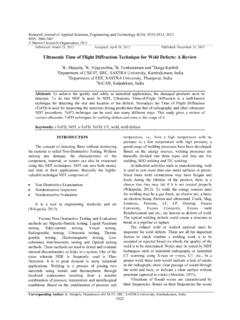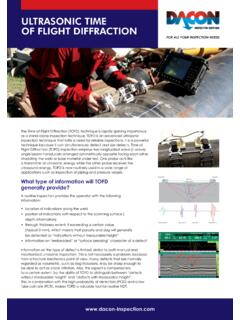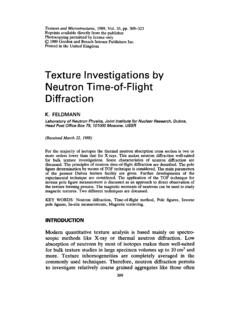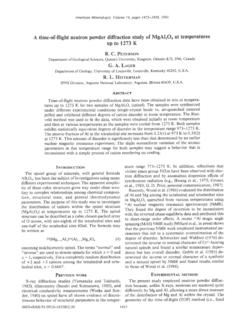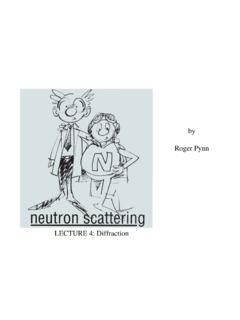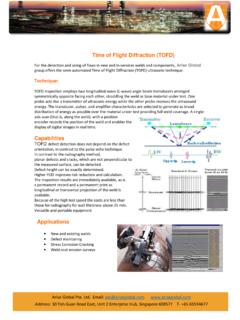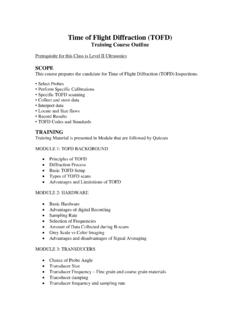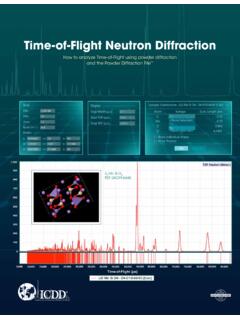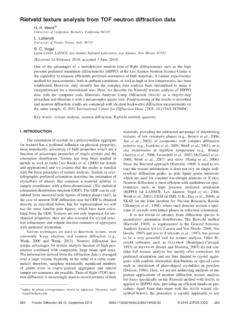Transcription of A Very Abbreviated Introduction to Powder Diffraction
1 A Very Abbreviated Introduction to Powder Diffraction Brian H. Toby Outline Where to go for more information What can we learn from Powder Diffraction ? Some background on crystallography Diffraction from single crystals Diffraction from powders Instruments for Powder Diffraction collection Materials effects in Powder Diffraction Crystallographic analysis of Powder Diffraction data (Total scattering/PDF analysis) 2 Where to go for There are many texts available. My favorites: 3 X-Ray Structure Determination: A Practical Guide (2nd Ed.)
2 , G. H. Stout, & L. H. Jensen (Wiley, 1989, ~$150) [Focused on small-molecule single crystal techniques, dated, but very easy to read; very good explanations of fundamentals. 1st book for many in field.] Fundamentals of Crystallography (2nd Ed.), Carmelo Giacovazzo, et al. (Oxford, 2002, ~$90) [Modern & very comprehensive, quite reasonable price considering quality, size & scope.] APS Web lectures on Powder Diffraction crystallography: : look for Education/Schools/ Powder Diffraction Crystallography ( ) Intended to introduce Rietveld refinement techniques with GSAS & EXPGUI Why do we do Powder Diffraction ?
3 Learn where the atoms are (single crystals are better for this, when available) Determine the phase(s) in a sample Measure lattice constants Quantify the components of a mixture Learn about physical specimen characteristics such as stress, preferred orientation or crystallite sizes Occupancies of elements amongst crystallographic sites 4 Basic Crystallography 5 The Lattice Crystals are constructed from repeated arrangements of atoms. Crystalline structure can be described as set of identical boxes stacked in 3D; the contents of each box is identical (exception: quasicrystals) A lattice is a mathematical concept where each lattice point describes an identical environment; lattice points are the corners of the identical boxes.
4 6 Commonly used phrases such as lattice compound or interstitials in the lattice misuse the concept of a lattice. Lattice planes General Indices: lattice planes are indexed by the inverse of where they cut each axis: Intercept of index=2 Intercept of (|| to axis) index=0 Related concept: Miller indices used for crystal faces Contain no common factors Notation: [ ] defines a direction [100] is along a axis 7 Single Crystal Diffraction 8 Diffraction from single crystals Diffraction occurs when the reciprocal lattice planes of a crystal are aligned at an angle with respect to the beam and the wavelength of an incident beam satisfies.
5 N 2 d sin (or better, 4 sin / Q) [Bragg s Law] d = 1/|d*| = 1/|ha* + kb* + lc*| 9 Single Crystal Diffraction Intensities The Intensity of a diffracted beam, Ihkl is related to a complex quantity called the structure factor, Fhkl Ihkl |Fhkl|2 The structure factor is determined by summing over all atoms in the crystal: Fhkl fi exp[2 i(hxi + kyi + lzi)] exp(-UiQ2/2) Since adding multiples of 1 to xi,yi or zi does not change the above, the sum can be simplified to include only the atoms of one unit cell fi represents the scattering power of an atom (also used, bi) Ui represents the average displacement of an atom from its ideal site 10 Powder Diffraction 11 Diffraction from random polycrystalline material In a sufficiently large, randomly oriented polycrystalline sample ( a Powder )
6 Contains a very large number of crystallites. A beam impinging on the sample will find a representative number of crystallites in the right orientation for Diffraction Diffraction occurs only at specific angles, those where Bragg s Law is satisfied. 12 Incident Beam Diffracted Beam Bragg cones in Powder Diffraction 13 Beam All reflections occurring at a single 2 value (as well as reflections at nearly the same value) are superimposed and only the sum of their intensities can be measured.
7 For this reason a Powder Diffraction pattern gives less information than a single crystal measurement Since there is a random distribution of crystals then Diffraction occurs in all directions for each Bragg angle, 2 , thus Powder Diffraction arises in cones Diffraction of X-rays versus Neutrons 14 Coherent Atomic Scattering Power ( Diffraction ) X-rays: The scattering power (form factor, fi) of an atom depends on the number of electrons in the atom and Q (Q sin / ) Neutrons: The scattering power (scattering length, bi) of an atom depends on the isotope and is independent of Q A few isotopes scatter with opposite phase to most, for these we write f (b) as negative Magnetic scattering is from electrons.
8 FM(Q) similar to x-rays 15 Q or sin / , -1 Structure factors: Fhkl = n fi exp[2 i(hxi + kyi + lzi)] exp(-UiQ2/2) Diffraction Intensity: Ihkl |Fhkl|2 Comparison of Neutron and X-ray Atomic Scattering Powers 16 17 Resonant Conditions X-rays X-ray form factor has in fact three components: f(Q) + f ( ) + i f ( ) f is determined by Q and the number of electrons in an atom and is independent of wavelength f and f are small except at wavelengths very close to an atom s absorption edge At wavelengths close to an edge absorption becomes high; fluorescence occurs above the edge.
9 Experiments are sometimes performed at wavelengths close to absorption edges to enhance the scattering from particular elements Neutrons Scattering lengths for most atoms are wavelength-independent. A few isotopes (mostly lanthanides and actinides) have adsorption edges at accessible wavelengths. This can be a problem with higher energy neutrons Some atoms scatter incoherently; Hydrogen (not deuterium) has a huge incoherent scattering cross-section that tends to overpower coherent scattering unless H is less than a few atom % 18 Types of Powder Diffraction Measurements 19 Measuring Powder Diffraction Angular dispersion: a single detector is moved over a range of 2 angles.
10 Sample irradiated with monochromatic radiation 20 Area Detection With an area detector, a complete Powder Diffraction pattern can be collected in a fraction of a second. Fast Medium resolution High background 21 Highest resolution requires high collimation. Optimal is a crystal analyzer between the sample and detector: 11-BM Diffractometer 22 beam Huber 480 rotation stage: high precision (~ ) high accuracy (~1arcsec) slew or step scans 12 analyzer array Si(111) crystals LaCl3 scintillator detectors 2 apart in 2.
